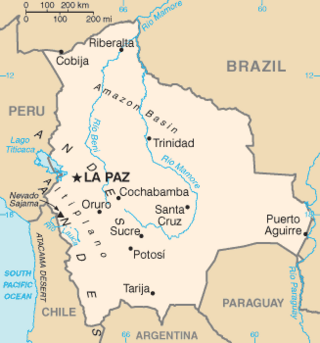Loading AI tools
Bolivia joined the IMF on December 27th, 1945.[1] Since 1984, Bolivia has been an active client for the fund, accessing five main separate credit lines from 1986 through 2005[2]. Currently, the country has no outstanding balance with the IMF, as the country is pulling away from such institutions.

With the overthrow of the mining elite, who dominated political life in Bolivia, the new government had the task of reorganizing the economy[3],in turn they decided to create an economy that is fair, therefore increased spending on public programs, plus the costs of nationalizing industries . By nationalizing the main exporting industries like mining. This generated growth in the economy, as commodities like tin, were paid well and were necessary for the creation of finished goods in other states, therefore frequent customers.
High government spending and an influx of foreign capital as well as actual growth, allowed the Bolivian economy to have impressive growth rates. By 1974, there is a surplus of 8.5% in GPD[4], mismanagement of growth by failing to re-invest int he economy causes future problems for the state.
Instead of funding economic activities, the state continued to expand its public expending, amassing large amounts of foreign debt. As the economy is not strong enough to fund these programs, the government turns to foreign loans from banks and public institutions[4].
Apart from deficit-financing, Bolivia remains overwhelmingly dependent on commodity exports, where Tin and Silver dominated. Making the state highly susceptible to market changes[3].
Due to high public spending by the government, the Bolivian economy begins to spiral. A decline in tax collection and the accumulation of foreign loans forces the state to find alternate ways to finance the deficit. The government responds by printing out large sums of money to finance deficit, which leads to high levels of inflation, where in 1985, the "inflation rate reached 11,750 percent" (Kehoe) [4].
This is turn creates more problems, as citizens are unwilling to hold to the Bolivian Peso due to instability of its value. [4] Bolivian banks begin to pay out in dollars, as citizens feared the peso was worthless as it's value fluctuated with an unpredictable market (FIND A SOURCE FOR THIS). The government is no longer in direct control of the country's currency, in order to slow down inflation, the government attempts to devalue the Peso by 40% [5] , decreasing its value, and imposes Dollarization programs to buy back the foreign capital and replace it with pesos. This however has little success. instead black market premiums surge and inflation continues to grow(SOURCE).
To make matters worse, during this time period we saw a sharp decrease in the price of non fuel commodity goods, such as tin. Bolivia's economy remains reliant on such commodities, therefore a decrease in pricing will destabilize the economy [6].
Wikiwand in your browser!
Seamless Wikipedia browsing. On steroids.
Every time you click a link to Wikipedia, Wiktionary or Wikiquote in your browser's search results, it will show the modern Wikiwand interface.
Wikiwand extension is a five stars, simple, with minimum permission required to keep your browsing private, safe and transparent.